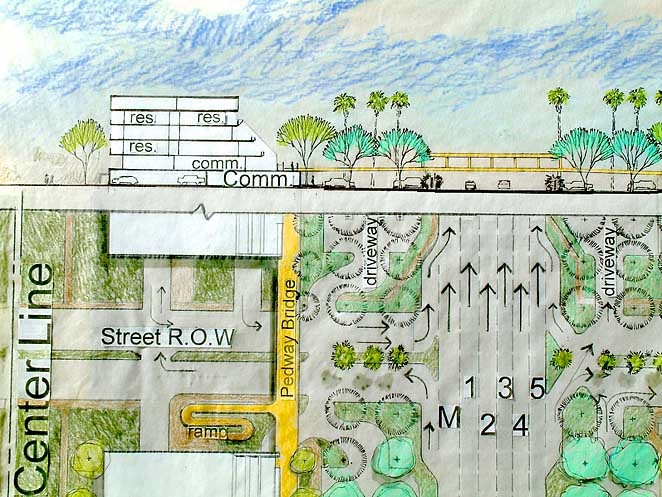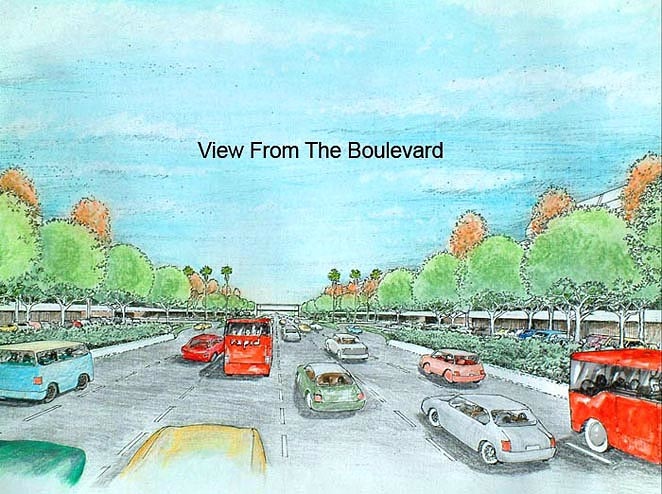FLOW BOULEVARD
Flow Boulevard and Community 2006
Abstract
Beginning with the LA Basin context, it is important to know what the many transportation deficiencies are that exist. So a transportation model is used with land use planning techniques. New traffic solving relationships are identified with the use of the Flow Boulevard (FB) concept and community renewal opportunities are exhibited. The resolution of transportation needs and problems becomes the basis for investment and urban re-development in some areas and in others it will be shown as a way to protect communities. The discussion between rail and vehicular transportation continues through the text.
Flow Boulevard 2006
Bullet Points (Contents of this Section)
- Why Los Angeles Has Traffic Congestion
- Fix the Traffic and Renew Communities with Flow Boulevards
- Evolve Existing Streets and Boulevards
- Review the Traffic Solution
- The Flow Boulevard Alternative Is Clearly the Right Choice
- Let the Automobile Evolve the Desired Future Urban Form
- The Venice-Washington Boulevard Corridor
- Evolve the Urban Socio-Economics
- New Blocks and Block Organizations
- Block Corporations
- Infrastructure Development
- Venice-Washington Flow Boulevard Capacity
- Western-Oxford Flow Boulevard Capacity
Why Los Angeles has Traffic Congestion
Central Los Angeles has traffic congestion on its streets and freeways and there are very good reasons for it. In the central area, from downtown to the 405, three freeways that were originally planned did not get built; the Beverly Hills (route 2), the Laurel (route 170),and the Whitnal (route 258). So inadequate infrastructure is the first reason for congestion.

The second reason may fall into the realm characterized by the word sprawl. Driving to the single family detached dream house, further and further out has been the mechanism. A trip to work that may have been five miles years ago is possibly now 25 or more. More time on the road.
Where there was once a balance between street and freeway facilities with land use that generated the vehicular trips, there no longer is balance. Longer and longer trips generate through traffic. Twice the length of trips nearly equals twice the amount of traffic without adding cars in some sections.



This effect is especially so in the central area where external and intermediate surrounding trip generation moves to and through the center to the areas beyond. And of course in the afternoon and evening you have the return trips.
Fix the Traffic Congestion and Renew Communities with Flow Boulevards
The Direction Los Angeles must go in is to provide facilities but not freeways, to fill in the gaps in our regional freeway network of circulation, and to provide more appropriate housing and communities, - rethink the dream-! Concentrating on the Mid-City area to begin with, I am proposing a transportation and community redevelopment concept to do just that. I have named the transportation concept Flow Boulevards (FBs) with the third stage of their evolution being Continuous Flow Boulevards (CFBs). Continuously flowing like freeways, but in places like boulevards. This transportation backbone is where the renewed communities develop.

The renewed communities will have greater density of land use. There will be higher density not only for housing, but for employment, education, recreation, shopping and entertainment. Along with the improved circulation will be an army of buses for transit users along the corridor and connecting with the many cross corridor bus lines at arterials. This is how you can get some of us out of our cars! However, you would think that the sequence is first providing for the circulation of cars and other vehicles. But in this case, providing for cars truly provides for rapid transit and for the movement of goods,- it is integral-.
Evolve Existing Streets and Boulevards
The improvement I propose for vehicular travel is based upon a pair of one way surface streets separated by a single block or more. Separating the direction of travel by a block or more allows the omission of the time wasting left hand turn signal from stopping opposing traffic as is the condition on a typical two way street. That is a start. Secondly, local streets will no longer cross the boulevard but will merge with the Flow Boulevard. This will curtail the many low volume trips from low density residential areas to other low density areas across the boulevard that stop the major traffic flow along the boulevard. Arterials on a mile (maybe closer in some cases) interval would be used for that. To get more of an idea of the turning movements see the menu section called How the Flow Boulevard Works. This present discussion is more conceptual in general terms.
With one way traffic and reduced signals, synchronization of signals to gain flow is a real possibility. Not so now on Santa Monica Boulevard for example. With two way traffic, having lights every couple of blocks, there is no way you can synchronize lights for traffic flow. Given the necessity to let people cross from side to side, this time interval in combination with two way traffic means signals must be approximately a quarter mile apart to accommodate all the time intervals for people and cars. So synchronization of street signals does not work in densely developed streets with many signals. In this condition, the density of land use and people crossing the street, car traffic slows down to about eight miles per hour, as is the case on Santa Monica Boulevard through the Hollywoods.
So the other integral concept of the Flow Boulevard (FB) is to bring the pedestrian up and out of the street at ground level. In fact, given that the FB is built within existing boulevard rights-of-ways, the major thing that is built is the elevated pedestrian circulation up and over the FBs.



The elevated pedestrian circulation not only lets the vehicles flow without signals to stop traffic for people to cross the street, it will provide the safe, aesthetic “public places” that are so much needed here in Los Angeles. The elevated circulation fills in by adjacent buildings giving, roof space in essence, to continue the pedestrian circulation and access along and through the built environment that also connects to ground level bus service, parks, parking and related uses.




The basic building, in the corridor, is one where parking is provided at grade level. Therefore expensive subterranean parking is avoided and the environmental impact of exporting hundreds of thousands of cubic yards of excavation along the corridor. Portions of the typical parking structure roof are given over to the raised pedestrian circulation. The housing or commercial is built over the parking so the pedestrian has level access at the raised circulation level. And so the raised pedestrian circulation develops.
Over time the pedestrian is brought out of the street at ground level. So as density develops along the corridor, pedestrians are not fighting for signal time and stopping traffic to get across the boulevard. By building places for pedestrians, these safe and aesthetic “urban dream places”, you will eventually get vehicular capacity (not speeds) equal to that of a freeway, which become guideways for what ever kind of transit seems reasonable (buses at first) and the impetus to rebuild major areas of Los Angeles into more appropriate and functional land uses.
To me, building the Flow Boulevard and the renewed urban community provides the basis to build a strong, creative, and capable urban middle class that will use urbanity to the benefit of society. Beginning with people that live in these corridors, their shares invested with others that join them become a process of development that not only makes better urban places and flowing vehicular circulation but technical, cultural and socio-economic improvement for a better urban life.
Review of the Traffic Solution
So to review; By building safe, aesthetic pedestrian circulation, you obtain urban boulevards that infill and make up for omissions in the freeway grid thus alleviating the failing existing overworked segments of the freeway network, the 10, the 101, and the 405. This extends the life and workability of our only true regional transportation network, the freeway system. Very good news, because Caltrans says there will be no new urban freeways. Which is further good news because freeways are so destructive to the communities they go through.
The elevated pedestrian circulation is integral with the rebuilding of vehicular circulation in Los Angeles, of redeveloping aging communities, of creating new urban environment, of resource conservation, of employment and the improved urban life. Well that seems to be a reasonable amount of benefit by building pedestrian circulation over Flow Boulevards! As an urban designer, I enjoy what is now considered as an expensive urban amenity, -safe, aesthetic pedestrian space and circulation- ,as being so fundamental to such savings, efficiency, conservation, education, fixes the freeway system and gives form to important new community redevelopment. Because of building pedestrian circulation !
The Flow Boulevard Is Clearly the Right Choice
Investment and urban development can not effectively be applied until there is an established planning solution to the traffic problems in Los Angeles. Why would you build a building that is hard to get to or will be out of the intended activity area? Clearly we need resolved, practical and affordable –urban design plans- !
The transportation policy, and it really seems to be an ingrained policy, of allowing greater congestion to force people out of their cars because deficiencies have been allowed to occur in the transportation system, is perverse and misdirected. Letting vehicles grind in congestion is so terribly wasteful of resources, time and what people can be doing instead of sitting in traffic! There is a glaring contrast between building Flow Boulevards and building rail transit, in terms of socio-economic and functional considerations.

Flow Boulevard Alternative: Rapid bus transit can be developed in existing populated corridors inexpensively and quickly with the first stage FB improvement. The transit dependent need an extensive, connected bus network across the many areas of Los Angeles; - they truly need it- ! I would think most of the upper income “choice riders” would rather drive than take a subway or light rail. The freeway deficiencies must be addressed because this affects the entire existing regional circulation system. By developing Flow Boulevards, freeway and local traffic become decongested. Needed new housing and community redevelopment, lets many people participate in the evolving economic improvements as a part of the process of making the urban setting more dense and efficient. This is appropriate for bus rapid transit along with reducing the tendency for the continued sprawl of Los Angeles.
Rail Transit Alternative: Rail transit costs much more, mile for mile, so less of it can be made. Extending the red line down Wilshire to the beach goes right through “choice rider” territory. It is guaranteed that a heavy rail ridership capacity would never be utilized in that corridor. And it would not alleviate the congestion of the 405 freeway problem in any way. If I lived on the Westside and wanted to go downtown; I would get in the Prius, take the Sepulveda to the Venice-Washington Flow Boulevard and go on downtown.
The MTA is advancing the Exposition light rail line that would connect with the existing blue line but on the other end it would dead end near Culver City. The Exposition corridor is an abandoned railroad alignment out of the existing development pattern. Another line of dubious worth. The MTA has a habit of making low demand disconnected rail routes. The I-105 corridor green line, notoriously known as the “nowhere to nowhere” rail line is another example. In both cases, the heavy and the light rail are under utilized.
Comparing the two alternatives; the Flow Boulevard is very constructive, whereas the rail alternatives are pathetic in utility and by sopping up the funding money that should be directed to real transportation improvement, they are really quite destructive. For further discussion on this point read the menu selection, “Comments on Rail Transit”.
As I covered in “Comments on Rail Transit” (see Menu), the MTA is saying “get out of your car” in the central city, and they are saying “get into your car” by building the many freeways and highways in suburbia. Are they trying to build two complete different systems, one highway and one rail, to the detriment that neither system is complete and working very well? The transit dependent bus riders are indicating that two different systems to do the same job is not working. The congestion we have in L.A. on freeways and streets is another indicator it is not working. There is not enough money for two complete systems. And as you can start to detect they are at odds with one another. Development is not happening where it should be. There are serious problems with this two system approach. Sprawl is compounding transportation problems. It is economically and environmentally destructive. To give the MTA more tax dollars to play with would not help matters either, they would just spend it!
The MTA can rationalize that they are building a regional system that some day will come together. Well in the meantime they are undercutting and damaging the existing system of regional transportation. I believe their vision of a regional system is without a real strategy. I think they are trying to make all the various cities happy, and their conflicting objectives. The tough problems are not being solved, but the easy problem solving they are doing is leading to bigger problems down the road. The MTA should not be allowed to subordinate the overall system to the narrow utility and worth so far demonstrated. Rail transit should be subordinate to the overall system and only used when there is actual integration and benefit to the overall system. So far this has not happened.
Another aspect of what is going on that concerns me is that there seems to be a professional intoxication with the rail transit idea. First transportation planning is isolated from planning for communities generally. Then they pump up huge projections of population increase and trip demand. They are now tossing around numbers like 6 million more people to arrive in the greater Los Angeles area in the near future. Why this just starts those rail lines spinning across the maps. I do not buy it ! The impact of wasteful spending on rail is especially detrimental when it is at the expense of making our existing system of circulation fail. If some of the old railroad rights of ways are so important, land bank those rights of ways for future use. Do not spend money on putting in rail systems that do very little and take money from the real problem solving of our current congested traffic dilemma.
FLOW BOULEVARDS 2006